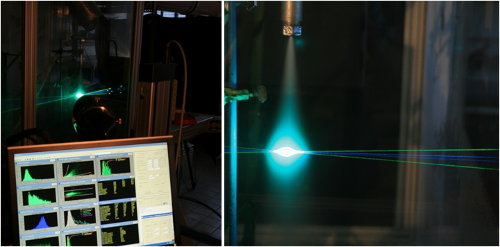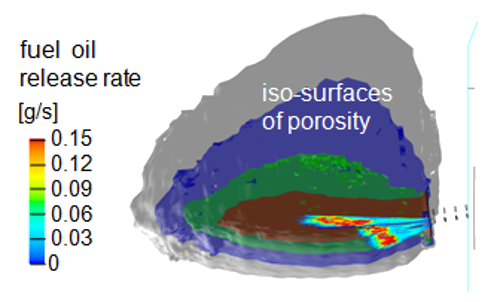Alternative Reductant Injection into the Raceway of the Blast Furnace
Objectives and Motivation
The classical blast furnace process utilizes coke as the main reducing agent to produce raw iron from iron ore. A proven approach to decrease coke demands and therefore the consumption of primary resources is the introduction of alternative carbon carriers, injected via lances through the tuyères into the raceway of the blast furnace. Prior to implementation of these measures on an industrial scale, thorough examination of the impact on the furnace operation is necessary. In current research activities CFD-models are developed to study the injection of plastic particles and heavy fuel oil into the blast furnace raceway.

Schematic illustration of the blast furnace highlighting the raceway zone
Experimental work
To provide for sound boundary conditions for the CFD-simulations, experimental investigation of droplet breakup and spray formation of heavy fuel oil injected into the raceway cavity is carried out. Applying PIV, LDA, PDA and high speed imaging combined with image processing, droplet size distributions at varying operating conditions are estimated.
Experimental investigation of physical and chemical plastic particle properties is done applying various relevant techniques, including thermolysis in TGA, Tammann furnace and short-time high temperature exposure reactors to simulate raceway conditions. The data set is used for validation of the particle submodels implemented in the CFD-code.

Analysis of spray characteristics using PDA
CFD simulation
The implemented modeling approach accounts for the flow of solid coke in the blast furnace as well as gaseous fluids by solving separate sets of conservation equations. Heterogeneous reactions and heat transfer effects are modelled by implementing source terms based on correlations describing the underlying physics. The model setup has been successfully validated using a number of heat transfer problems as well as setups including homogeneous and heterogeneous chemical reactions.
The model predictions will be used for the optimization of operating conditions of the blast furnace to contribute to a further decrease of the environmental impact of such facilities, also aiming at further improvement of plant efficiency and economics.

Carbon dioxide concentration profile, pathlines of blast flow and oil injection trajectories

Trajectories of injected fuel oil, iso-surfaces of porosity profile near the tuyère opening


